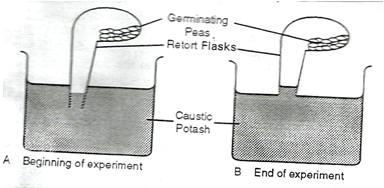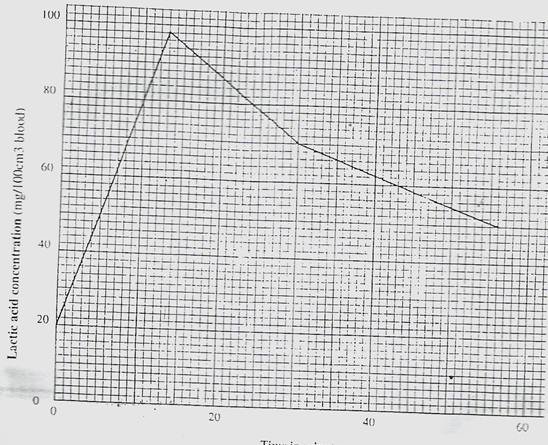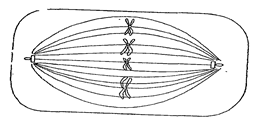INSTRUCTIONS TO CANDIDATES
- Answer all questions
- Name the blood vessel that suppIies:
- The heart with nutrients. (1mk)
- The foetus with oxygen (1mk)
- Explain why it is important to stain specimen to be observed under a light microscope. (2mks)
- What is wilting? (2mks)
- State the significance of the following steps while testing for disaccharide in food sample. (2mks)
- Addition of dilute hydrochloric acid
- Addition of sodium bicarbonate.
-
-
- Name the fluid produced by sebaceous gland. ( 1mk)
- State two function of the fluid name in 5 a) (i) above. ( 2mks)
- Explain how malpighian layer of the skin is adapted to perform its function. (1mk)
-
- A certain animal had one cell from its alimentary canal observed under light microscope. A total of 40 chromosomes were seen.
- State the number of chromosomes in
- The spermatozoan of this animal (1 mk)
- One of cells in the tongue. (1mk)
- Name a structure in mature plant where meiosis takes place. (1mk)
- State the number of chromosomes in
- A biological washing detergent contain enzymes which remove stain like mucus and oil from clothes which are soaked in water with the detergent.
- Explain why stain would be removed faster with detergent in water at 35°C rather than 50°C (1mk)
- Why is boiling clothes with the detergent less likely to remove stain. (1mk)
- Name an enzyme that catalyses the decomposition of sodium hydrogen carbonate to facilitate transportation of carbon (IV) Oxide. (1mk)
- Form 2 students from samba secondary school set up an experiment as shown below.

- Explain the change observed at the end of the experiment. (2mks)
- Explain what would happen if water has been used instead of potassium hydroxide. (2mks)
- State two advantages of metamorphosis to the life cycle of insects. (2mks)
- The concentration of lactic acid in blood during and after an exercise was determined. The results are shown in the graph below.

-
- By how much did the lactic acid increase at the end of 10 minutes? (1mk)
- After how many minutes was the lactic acid concentration 78mg/100cm3 ( 2mks)
- What would be the concentration of lactic acid at the 60th minutes. (1mk)
- Give a reason for the high rate of production of lactic acid during the exercise. (1mk)
-
- Name the part of human brain that perform the following function (2mks)
- Controls peristalsis
- Control intelligence
- Outline the differences between Darwin’s theory and Lamarck’s theory of evolution. (2mks)
- Give three functions of cystokinin hormone in plant . (3mks)
- Explain why plants do not require specialized excretory organ. (3mks)
- The diagram below represents a stage in cell division.
- Identify the stage of cell division (1mk)
- Give a reason for your answer (1mk)
- Outline three functions of colon . (3mks)
- State two advantages of closed circulatory systems in mammal. (2mks)
- Explain what happens to excess amino- acids in the liver of humans (3 Mks)
-
- Which portions of the human nephron are only found in the cortex? (3 mks)
-
- What would happen if a person produced less antidiuretic hormone? (2 marks)
- What term is given to the condition described in (b) (i) above (1 mark)
- Explain double fertilization as used in flowering plants. (2mks)
- State one survival value for each of the following in plants (1mark)
- Haptotropism in stems (1mark)
- Thigmonasty in Mimosa pudica
- What is meant by the term polyploidy? (1mark)
- Give an example of a genetic disorder caused by non-disjunction in somatic cell (1mark)
-
- Explain how mammalian trachea is adapted to its function ( 2mks)
- Name the gaseous exchange site in bony fish. (1mk)
- Explain the role of the following hormone in homeostasis
- Insulin ( 3mks)
- Aldosterone hormone when there is less water in blood stream. (2mks)
- Outline three difference between plant divisions Bryophyta and Pteridophyta (3mks)
- Name two products of light stage of photosynthesis that are useful in light independent stage. (2mks)
- State two functions of xylem tissue. ( 2mks)
- State two function of golgi apparatus ( 2mks)
MARKING SCHEME
-
- Coronary artery
- Umbilical vein
- Different structures absorbs stain differently hence become more distinct/clearer, visible.
- Rate of water absorption is more than water loss/transpiration and plant droops
-
- Hydrolyse (breaks down disaccharide/Non reducing sugar to monosaccharide/reducing sugar
- Neutralize the excess dilute hydrochloric acid
-
-
- Sebum
-
- antiseptic.kill pathogens
- Makes skin hair be soft/oily
- Makes hair flexible/waterproof
-
- actively dividing cells giving rise to the granular layer
- contain melanocyte cells that produce melanin that gives the skin its colour/protects skin against ultra violet rays.
-
-
-
- 20 chromosomes
- 40 chromosomes
- anther/ovary
-
-
- at 35°c temperature is at optimum while at 50°c enzymes are denatured
- Enzymes are denatured
- Carbonic anhydrase
-
- Germinating seeds respire using up oxygen and producing CO2, which dissolves in KOH creating a partial vacuum taken up by KOH
- No rise in the level of water sine the CO2 is insoluble in water
-
- reduces competition between two different stages
- Pupa can survive adverse conditions/pupa is a non feeding stage
- Dispersal prevents overcrowding
-
-
- 58mg/100 cm3
- 10 min/25 min
- 47mg/100 cm3
- tissues respired anaerobically since supply of oxygen was less than demand.
-
-
- Medulla oblongata
- Cerebrum
Lamarck’s theory Darwin’s theory i) deals with inheritance of acquired characteristics
ii) states that environment produces traits which are inheritedDeals with inheritance of genetically acquired characteristics
States that acquired characteristics are not inherited.-
- breaks dormancy in some plants
- Promotes flowerings in some plant species
- Promote cell division in the presence of light
- Promotes fruit formation on shoot
- Lower concentration of cytokinins enzymes senesence/ aging
- Normal concentration promotes cell enlargement
- It stabilizes protein and chlorophyll
- It stimulates lateral bud development
- Together with IAA , it forms callus tissue during healing of wound
-
- plants excretory products are less toxic
- Some excretory products are re-usable/recycle
- There is low accumulation of toxic waste products
- Excretory products are stored in harmless non-toxic form.
-
- metaphase I
-
- Chromosomes align themselves at the equator of the spindle fibre
- Chromosomes are all non- homologus
-
- absorption of water
- Packaging of indigestible food material to form feaces
- Secretion of mucus
- Absorption of mineral salts
-
- faster flow of blood to the tissue due to higher pressure generated to supply nutrients /remove of waste products/organisms involved are more active
- Blood is not in direct contact with body tissues hence white blood cells hence cells are not killed.
- Maintains steep concentration gradient for faster exchange of materials e.g capillaries.
-
- The amino acids are broken into amino group (NH2) and carboxyl group (COOH). The amino group combines with hydrogen forming highly toxic ammonia. It immediately combines with carbon (IV) oxide forming urea that is less toxic.
- The carboxyl group converted to carbohydrates and then oxidized or converted into neutral fats and deposited on the parts of the human (3 Mks)
-
-
- Bowman’s capsule
- Proximal convoluted tubule
- Distal convoluted tubule
- glomurulus (3Mks)
-
- Less water reabsorbed into the blood stream and large volume of dilute urine is produced (2 Mks)
- Diabetes insipidus /Diuresis (1 Mk)
-
- One molecule fuses with functional egg cell to form a diploid zygote. The other male nucleus fuse with the two polar nuclei to form primary endosperm
-
- Enables climbing plants to get support in order to receive sunlight for photosynthesis.
- Enables the plant to protect itself from harm.
- A condition where an organism possess more than two sets of chromosomes.
- Downs syndrome
-
-
- hollow for the passage of respiratory gases
- Numerous goblet cells to produce mucus to trap dust particles/micro-organisms.
- has cartilaginous rings to keep the trachea open/prevent it from collapse during inspiration.
- Cilia that moves mucus/particles to the top of he trachea and removal
- Gill filament
-
-
-
- stimulates liver cells; to convert excess glucose to glycogen for storage in the liver; to fat for storage in adipose tissues; facilitate oxidative breakdown of excess glucose to CO2 , ATP and H2O
- Increase absorption of glucose in body cells.
- stimulate DCT and collecting ducts to become more permeable; to water and move water is reabsorbed into the blood stream.
-
-
BRYOPHYTA PTERIDOPHYTA - Plant body is thalloid Plant body differentiated into roots/stems and leaves - Lacks vascular bundles Has vascular bundles - Gametophyte is dorminant generator Sporophyte is dorminant generation -
- Hydrogen toms;/ions
- ATP-adenosine triphosphate
-
- Transport of water and mineral salt
- Support
-
- Packaging of glycoprotein and
- Transporting of glycoprotein
- Formation of lysosomes
Download Biology Paper 1 Questions and Answers - Momaliche Joint Pre Mock Exams 2022.
Tap Here to Download for 50/-
Get on WhatsApp for 50/-
Why download?
- ✔ To read offline at any time.
- ✔ To Print at your convenience
- ✔ Share Easily with Friends / Students


